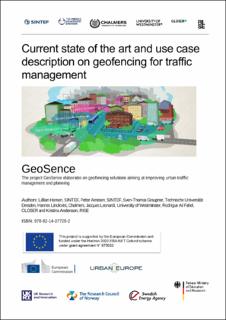| dc.description.abstract | This report is a result of a literature review and document gathering focused on geofence use cases specific for road traffic management. It presents geofence use cases that are trialled or to be trialled, implemented use cases, as well as conceptual and potential future use cases, showing for which type of transport they are used and how geofence zones are applied or to be applied. The report was conducted in the project GeoSence – Geofencing strategies for implementation in urban traffic management and planning. It is a Joint programme initiative (JPI) Urban Europe project funded by European Union´s Horizon 2020, under ERA-NET Cofund Urban Accessibility and Connectivity and gather project partners from Germany, Norway, Sweden and UK. The goal is to present the current state of art, and describe use cases, based on the working definition of geofencing in the project, where geofence is defined as a virtual geographically located boundary, statically or dynamically defined. The study shows that for implemented and real-traffic trial use case, geofencing has been applied within private car transport, shared micro-mobility, freight and logistics, public bus transportation and ridesourcing. For the future use cases, geofencing has been tested or conceptually developed also for automated vehicles and shared automated mobility, among others. The report summarises main use cases and find them to answering to especially four challenges in traffic management: safety, environment, efficiency, and tracking and data collection. Some of the use cases however answer to several of these challenges, such as differentiated road charging, and the use cases in micro-mobility. Further, the system and functionality of the trialled and/or implemented use cases, show different types of regulation geofence use cases can be used for, from informing, assisting, full enforcement, incentivising and penalisation. Guidelines and recommendations so far form national authorities show that the existence of joint regulation or guidelines for the use of geofencing for different use cases is low – with some exceptions. Digital representation of traffic regulation will be crucial for enabling geofencing. | en_US |
